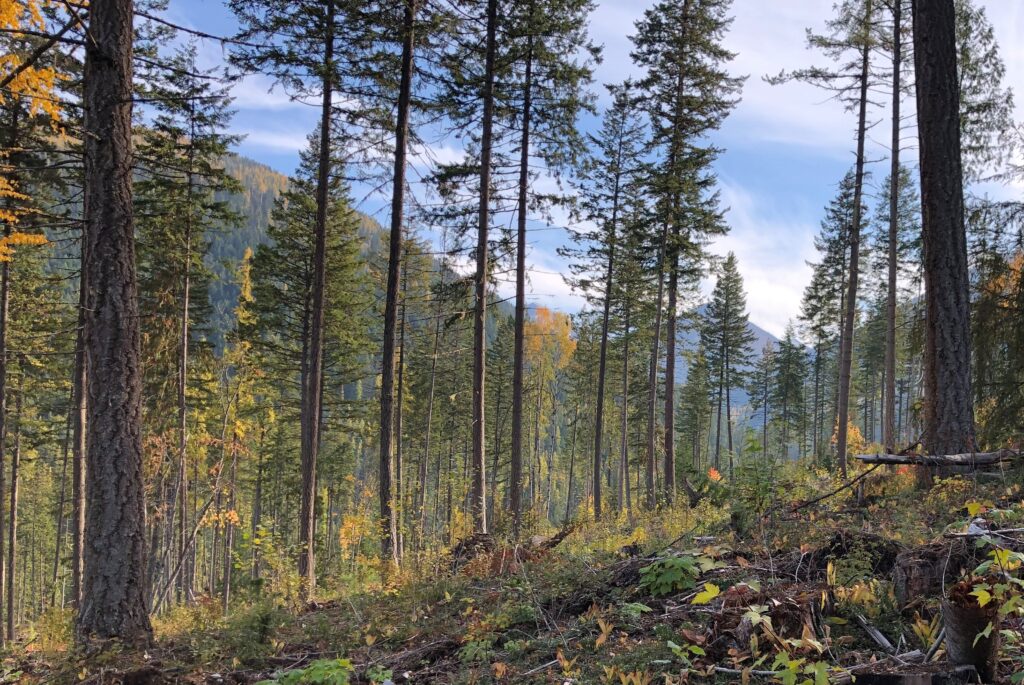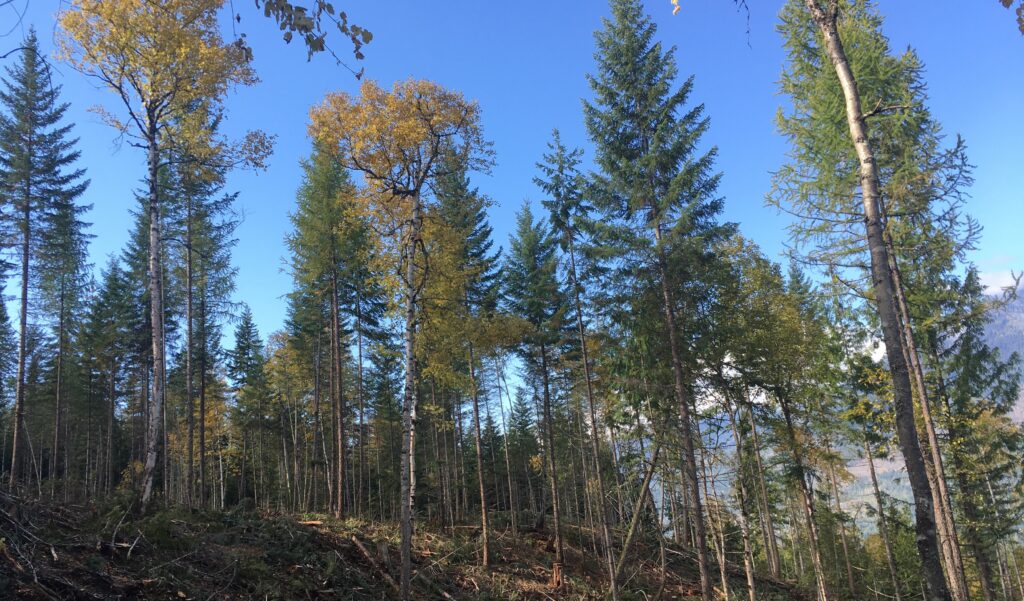Procter and Harrop, B.C.: A small West Kootenay community forest is implementing an ambitious climate action plan that uses forest thinning to reduce wildfire risks while also reducing carbon emissions. With support from the Forest Enhancement Society of BC (FESBC), uneconomic low-value fibre from mechanical fuel treatment projects is being shipped to a local pulp mill to avoid burning and to reduce the carbon footprint of operations.
With an annual harvest of only 10,000 cubic metres (equal to approximately 200 truckloads), the Harrop-Procter Community Co-operative (HPCC) is one of the smallest community forests in the province. Despite its small size, HPCC has been a leader in demonstrating how forest management practices can be used to adapt to a changing climate while simultaneously working to reduce carbon emissions.
Left Bottom Photo: Small diameter and rotten trees removed during fuel treatment operations. This low value fibre was shipped to the local pulp mill;
Right Bottom Photo: Large healthy trees retained on site after fuel treatment in Harrop;
Photo credits: Erik Leslie, Forest Manager with the Harrop-Procter Community Co-operative.
“The Forest Enhancement Society of BC is a proven partner in delivering projects on the ground that benefit communities, workers, and the health of our forests,” said Bruce Ralston, Minister of Forests. “We are building on this foundation with an additional investment of $50 million for the Society to expand funding for projects that increase access to fibre, reduce emissions from slash pile burning and reduce the risk to people from wildfire.”
Several FESBC-funded projects in the communities of Harrop and Procter have generated significant carbon benefits. Over the last three years, FESBC has funded portions of the transportation costs required for the Community Forest to ship low-value fibre to the local pulp mill and break even while doing so. With $94,429 of FESBC support, roughly 8,533 cubic metres of pulp logs that would otherwise be burned on-site, were instead hauled and utilized. The reduction in carbon emissions to the environment, as a direct result of this work, is estimated at 4,149 tonnes CO2e, which is equivalent to taking 890 cars off the road for one year.
“Eliminating slash pile burning is a low-hanging fruit for carbon initiatives,” explained Erik Leslie, RPF, HPCC’s Forest Manager. “The benefit is immediate because we’re avoiding emitting carbon, starting on day one. Our fuel treatment operations require the removal of lots of small diameter trees, and we don’t want to just burn them, rather we’re trying to use them instead.”
For the HPCC project, the cost per tonne of avoided emissions was $22.67, which is significantly lower than the costs of other greenhouse gas avoidance programs being offered in B.C. These projects are also aligned with other government priorities, including creating better outcomes that impact human health, in this case by choosing not to burn the 8,523 cubic meters of fibre resulted in the avoidance of approximately 20,000 kg of smoke particulates (P.M. 2.5) into the local airshed.
The HPCC is a community-owned, not-for-profit with over 200 members and has been managing the 11,300-hectare Community Forest, one of the first community forests awarded in British Columbia, since 2000.
In 2021, the Office of the Chief Forester partnered with HPCC, and using FESBC funds, planted 200,000 seedlings in the heavily burned area of the 2017 Harrop Creek fire with the goal of establishing tree cover quickly to help protect the long-term hydrology of the impacted watershed. The planted trees are also expected to continue sequestering carbon from the atmosphere over the coming decades.
“The Harrop-Procter Community Co-operative’s desire to reduce burning is shared by many citizens of B.C. We now have the tools to measure the greenhouse gas reductions by utilizing low-value fibre, and when we compare these results to burning fossil fuels or the carbon tax, this knowledge becomes both informative and powerful. Removing the equivalent of 890 vehicles off the road by using fibre we used to burn just makes sense,” said Brian Watson, RPF, Operations Manager with FESBC. “This Community Forest first showed us how small tenure holders can sustain value-added sawmills. Now, they are leading the way on reducing greenhouse gas emissions and it’s a great story.”
FESBC would like to gratefully acknowledge the financial support of the Province of British Columbia through the Ministry of Forests.



